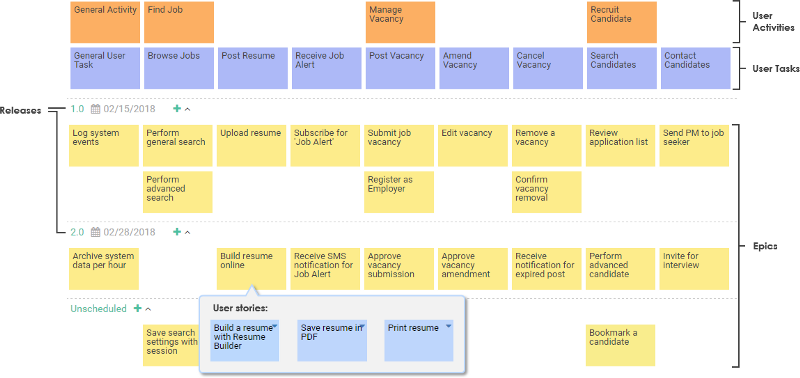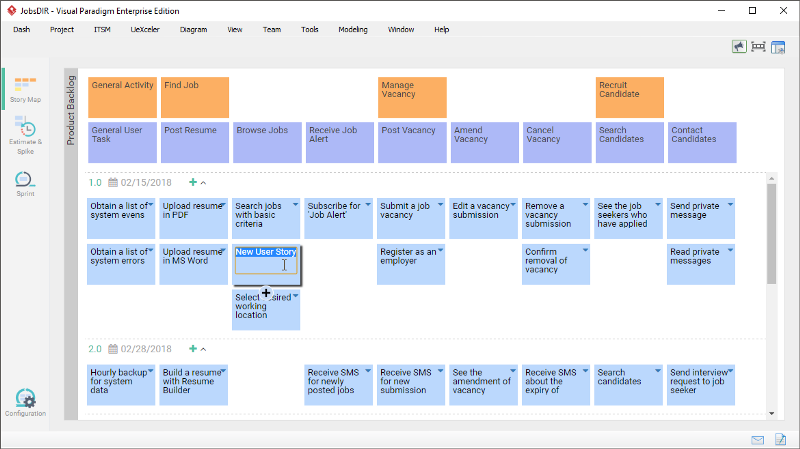نقشهبرداری داستان کاربر یک رویکرد بصری ساختارمند برای تیمهای اسکرام فراهم میکند تا بتوانند موجودی محصول را مدیریت کنند.
نقشه داستان بصری امکان ترتیبدهی به هسته محصول (فعالیتهای کاربر)، وظایف کاربر، اپیکها و داستانهای کاربر را به طور مؤثر در یک ساختار قابل مدیریت از بالا به پایین فراهم میکند، که بر اساس ماهیت، اولویت و سطح پیچیدگی اقلام نقشه است.

ابزار چابک پارادایم بصری برای حداکثر کردن بهرهوری و کارایی پروژههای اسکرام از طریق نقشهبرداری داستان چابک طراحی شده است.
- زمانی که یک مورد را بکشید، ما به شما کمک میکنیم تا کل شاخه را جابجا کنید و طرح را بهروزرسانی کنید.
- زمانی که یک مورد را به نقشه داستان اضافه میکنید، ما بخش دیگر نقشه را دوباره ترتیب میدهیم تا از صحت محتوا اطمینان حاصل کنیم.
- چندین طرح موجودی (یعنی ساختار نقشه ۳ یا ۴ سطحی) برای پشتیبانی از هر مقیاس پروژه ارائه شده است.
- این یک ابزار توسعه نرمافزار چابک است که به راحتی با اسکرام سازگار و شهودی است.

ویژگیهای عالی برای مدیریت مؤثر موجودی محصول:
فعالیتهای کاربر، وظایف و داستانها
موجودی محصول را به اقلام قابل مدیریت موجودی محصول تقسیم کنید. ساختار استاندارد ۳ سطحی شامل فعالیتهای کاربر، وظایف کاربر و داستانهای کاربر است.
اپیکها
نقشه داستان ۴ سطحی یک سطح اپیک را بین وظایف کاربر و داستانهای کاربر معرفی میکند، که برای پروژههای با پیچیدگی بالاتر مناسب است.
برنامهریزی انتشار
داستانهای کاربر میتوانند در بخشهای انتشار نگهداری شوند، که نشاندهنده یک برنامه تحویل است که توسط تیم و ذینفع توافق شده است.
کشیدن و رها کردن پیشرفته
عناصر در یک نقشه داستان میتوانند با کشیدن دوباره ترتیب داده شوند. و زمانی که شما بکشید، کل شاخه عناصر دنبال خواهد شد. اولویتبندی و دوباره ترتیب دادن داستانها میتواند به طور شهودی و آسان انجام شود.
ویرایش درونخطی
تمام عناصر میتوانند به صورت درونخطی تغییر نام داده شوند. شما نیازی به عبور از هیچ پنجره یا مرحلهای ندارید.
عناصر را با کلیک اضافه کنید
برای اضافه کردن یک داستان کاربر زیر یک وظیفه کاربر، یا برای اضافه کردن یک خواهر از فعالیت کاربر، هر دو میتوانند با یک کلیک انجام شوند. دکمه شناور موقتی امکان اضافه کردن عناصر نقشه داستان را به طور شهودی فراهم میکند.
ابزار توسعه چابک پارادایم بصری برای نقشهبرداری داستان
چگونه یک نقشه داستان کاربر ایجاد کنیم
چگونه برنامهریزی انتشار را در نقشه داستان کاربر انجام دهیم
This post is also available in Deutsch, English, Español, Français, Bahasa Indonesia, 日本語, Polski, Portuguese, Ру́сский, Việt Nam, 简体中文 and 繁體中文.













